Dorylus (Dorylus) helvolus (Linnaeus)
 Male Male   Type locality South
Africa (Vespa helvola, Linnaeus, 1764: 412, male;
illustrated by Coquebert, 1798, Plate XVI) from Cape of Good Hope,
Tulbagh - no images on Antweb (December 2017). Type locality South
Africa (Vespa helvola, Linnaeus, 1764: 412, male;
illustrated by Coquebert, 1798, Plate XVI) from Cape of Good Hope,
Tulbagh - no images on Antweb (December 2017).
junior synonyms
dorylus (Mutilla dorylus, Lamarck, 1817: 101,
male; minimal description,
apparently simply reporting the Linnaeus description but using a
different name) from "Africa" - no images on Antweb (December 2017).
europaea (Typhlopone europaea,
Roger, 1859: 248, illustrated clypeus, worker; synonymy by Emery,
1888b: 350) from Italy (location of insect collection not of
source?; from Königl collection in Berlin) - see the set of workers at https://www.antweb.org/specimen.do?name=focol1083 etc.
planifrons (Dorylus
planifrons nov. sp., Mayr, 1865: 74, male, illustrated) from South
Africa, Cape of Good Hope - no images on Antweb (December 2017).
punctata (Typhlopone punctata,
F Smith, 1858b: 112, worker) from South Africa, Cape of Good
Hope - no images on Antweb (December 2017).
subspecies pretoriae (Dorylus
helvolus L. subsp. pretoriae
n. subsp., Arnold, 1946: 59, all forms, illustrated) from South
Africa - no images on Antweb (December 2017).
all forms described (see Bolton, 1995). 
|
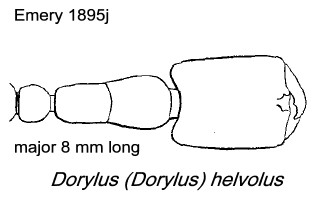 Linnaeus's (1764) brief description of the male is at Linnaeus's (1764) brief description of the male is at  ; The Fabricius (1793: 365) genus
definition and description of D. helvolus, as type species is
at ; The Fabricius (1793: 365) genus
definition and description of D. helvolus, as type species is
at  . Lepeletier de Saint-Fargeau (1835: 213)
gave a description, this is at . Lepeletier de Saint-Fargeau (1835: 213)
gave a description, this is at  . Emery (1895j: 714) gave a full,
illustrated description; this is at . Emery (1895j: 714) gave a full,
illustrated description; this is at  ; with the illustrations on ; with the illustrations on  . Smith's (1858b) brief description of punctata
is at . Smith's (1858b) brief description of punctata
is at  ; Roger's (1859)
description of europaea (drawing of the clypeus unavailable) is
at ; Roger's (1859)
description of europaea (drawing of the clypeus unavailable) is
at  ; Mayr's (1865) illustrated description of
the planifrons male is at ; Mayr's (1865) illustrated description of
the planifrons male is at  ; Arnold's (1946) illustrated description
of pretoriae is at ; Arnold's (1946) illustrated description
of pretoriae is at  . .
Wheeler (1922) listed it also from Togo (Bismarckburg,
Büttner), Nigeria (Agege by W.A. Lamborn); plus many mostly
southern Africa records.
I suspect the records from countries outside of southern
Africa were misidentifications. The Roger description of Typhlopone
europaea gave the specimens as several workers apparently collected
by Bonelli at Turin and in the Königl. collection in Berlin. In his
list of species, Emery (1888b: 349) gave "hab. Africa australis"
listing europaea as a junior synonym of helvolus
without comment.
|
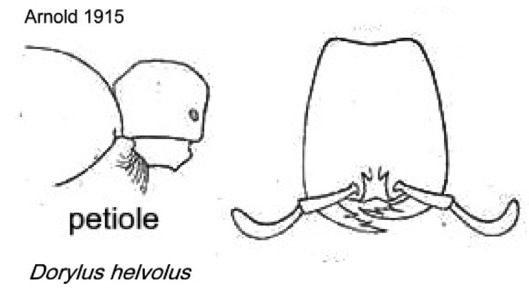 Arnold (1915: 116)
had the following description and the
image (right, apparently of a minor worker) - Arnold (1915: 116)
had the following description and the
image (right, apparently of a minor worker) -
"Soldier or worker maxima - TL 8 mm; castaneous, mandibles and anterior
portion of head and apical segments of gaster, darker. Legs very
scantily pubescent, funiculus moderately pubescent, a few long hairs on
the petiole and abdominal segments. Whole body, except the posterior
face of the node and the funiculus, very shining, evenly and distinctly
punctured. The punctures are larger and deeper on the head and thorax,
shallower and smaller on the petiole and gaster. The petiole is
reticulate-punctate on its posterior face, from each puncture arises a
pale microscopic hair.
Head at least one-quarter longer than it is wide, parallel-sided,
slightly narrower behind, posterior angles rounded but very prominent,
owing to the deep and almost angular occipital emargination. Mandibles
scarcely longer than half the width of the bead, very blunt at the
apex, and with a blunt tooth near the middle of the internal margin.
Clypeus almost linear, except in the middle, where it is slightly and
triangularly extended between the frontal carinae, and produced into a
small platform on the anterior margin. The frontal carinae short and
narrow, free and raised at the sides into a lobe which ends posteriorly
in a sharp spine. Scape of antenna incrassate and flattened towards the
apex, about two-thirds as long as the funiculus; the latter 10-jointed,
all the joints except the last wider than long. The scape and funiculus
together are about three-quarters the length of the head.
|
|
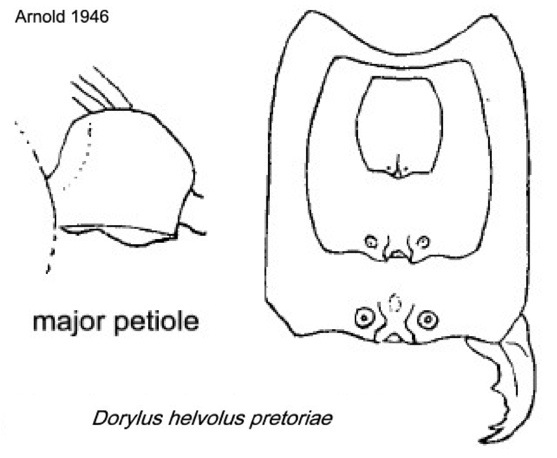 Pronotum rounded in
front, narrower behind than in front.
Pro-mesonotal suture well defined; mesonotum and propodeum rather
flattened above, declivity of the propodeum vertical and very short.
Node of petiole quadrate-globose, slightly wider behind than in front,
the ventral lamella produced in a wide angle. First gastral segment
narrow at the base, 2nd and 3rd segments sub-equal, and a little longer
than the 1st, 4th segment a little shorter than the preceding, 5th
segment widely and semicircularly excavated apically, the dorsal
boundary of the excavation forming a sharp edge, ending on each side
inferiorly in a short tooth. Pronotum rounded in
front, narrower behind than in front.
Pro-mesonotal suture well defined; mesonotum and propodeum rather
flattened above, declivity of the propodeum vertical and very short.
Node of petiole quadrate-globose, slightly wider behind than in front,
the ventral lamella produced in a wide angle. First gastral segment
narrow at the base, 2nd and 3rd segments sub-equal, and a little longer
than the 1st, 4th segment a little shorter than the preceding, 5th
segment widely and semicircularly excavated apically, the dorsal
boundary of the excavation forming a sharp edge, ending on each side
inferiorly in a short tooth.
Minor worker - TL 5-6 mm. This differs from the major in the following
characters. The colour is slightly lighter, and the head is a little
narrower behind than in front, and is only arcuately emarginate behind.
The apex of the mandible is not blunt, but ends in two sharp teeth, the
lower tooth being the larger; the tooth on the inner margin is also
acute. The pubescent hairs on the body are longer.
Minima worker - TL 1.7-2 mm. Colour pale dirty yellow. Funiculus
9-jointed. Pilosity and pubescence stronger than in the minor.
Mandibles without a tooth on the internal margin, and with the upper
apical tooth almost obsolete, making the mandible an elongate triangle.
This species has been recorded from the larger part of the South
African region. In Zimbabwe it is common, and more frequently met with
than any other species of the genus. (S.A.M., R.M., G.A. colls.)"
|
Oxford University Museum
specimens
Dorylus (Dorylus) helvolus
B Taylor det.
Male
|
Central African
Republic
P Annoyer
1998-05
|
16.vi.1998
Dzanga-Sangha
|
Bayanga-Lidjombo;
U.V. 19h-05h; LAYON PK 21 5.0 RCA
|
1
|
 |
Dorylus (Dorylus) helvolus
B Taylor det. |
South Africa
Peter Hlavác
|
25-26.i.2004
Grootvadersbosch
33°59.39' S
20°48.32' E
|
Western Cape,
Grootvadersbosch N.R., S E ; 350 m
|
5
|
 |
Dorylus (Dorylus) helvolus
B Taylor det.
|
Uganda
A W McCrae
OUMNH-2006-077
|
18.v.1965
Lolui I
Lake Victoria
|
on dead monkey
|
1
|
 |
|
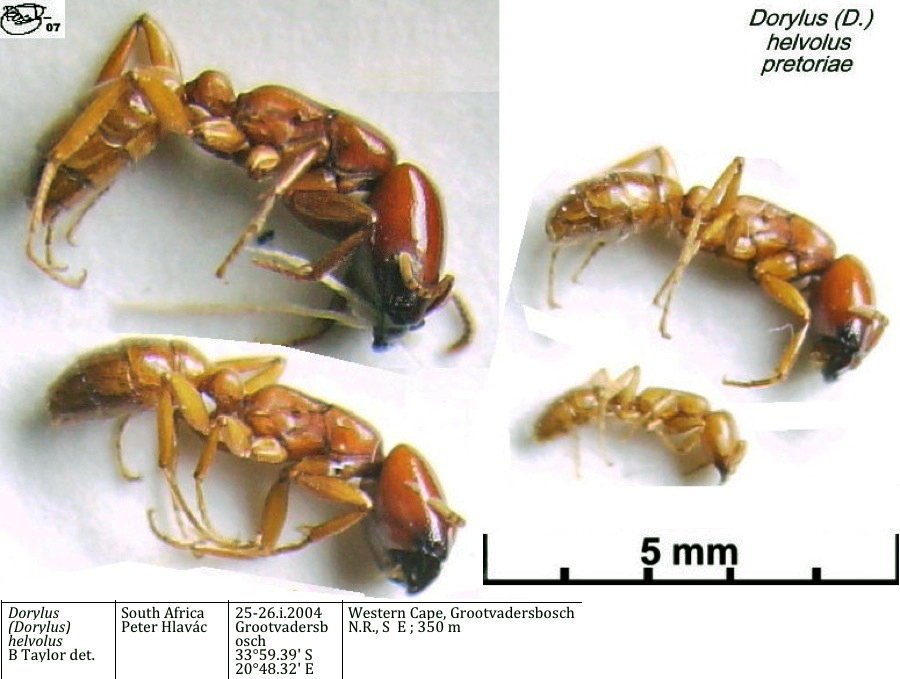 Polymorphism Polymorphism
The photomontages are of workers from South Africa;
Grootvadersbosch National Reserve, Western Cape; collector Peter
Hlavac; nest
under bark. These match the europaea workers available on Antweb/Focol (see link above).
The various morphs are shown in detail on Dorylus (Anomma) helvolus
morphs page.
|
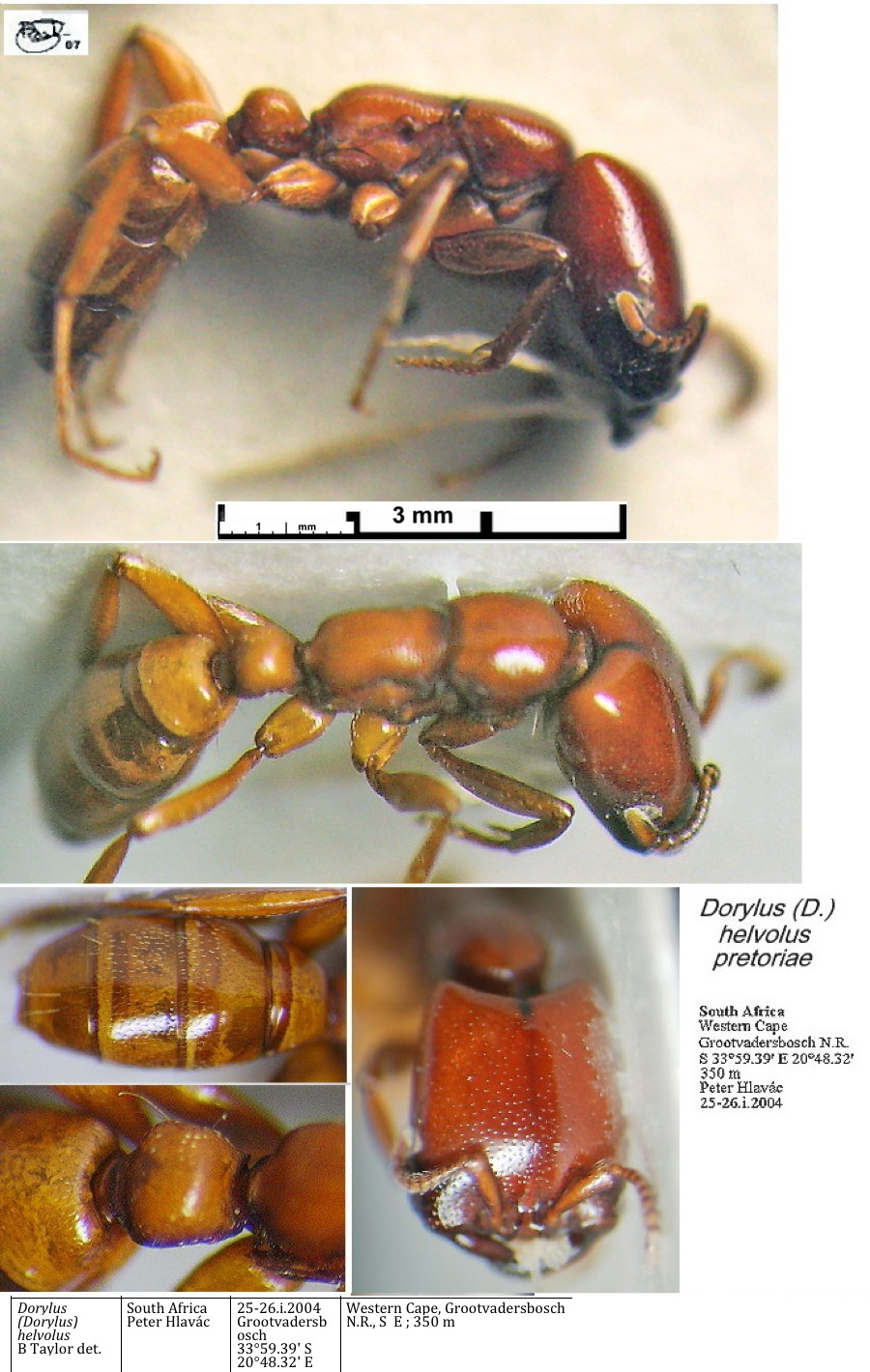 Major Major
|

|
 MALES MALES
|
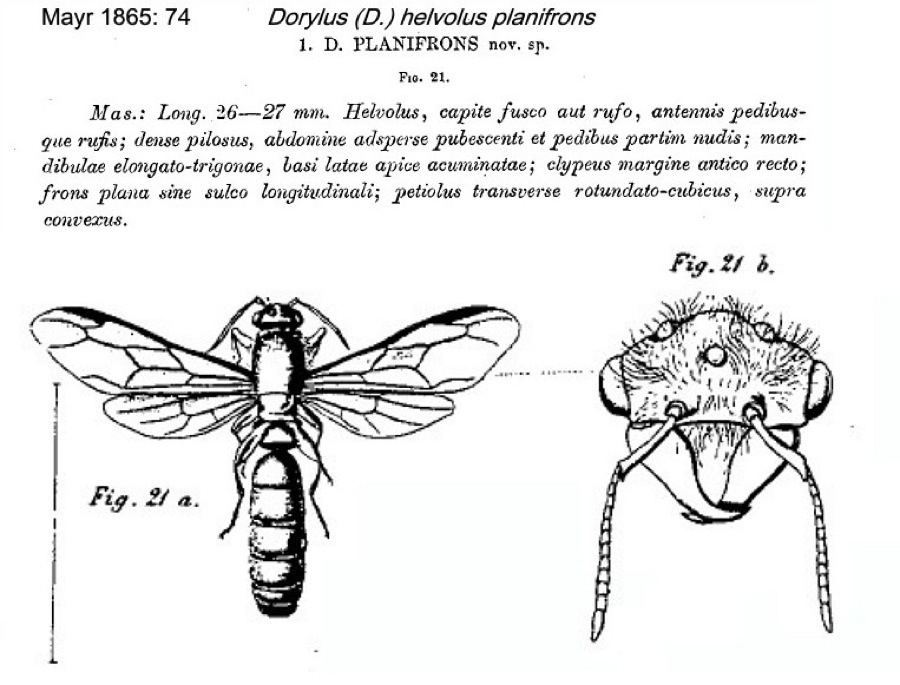
|
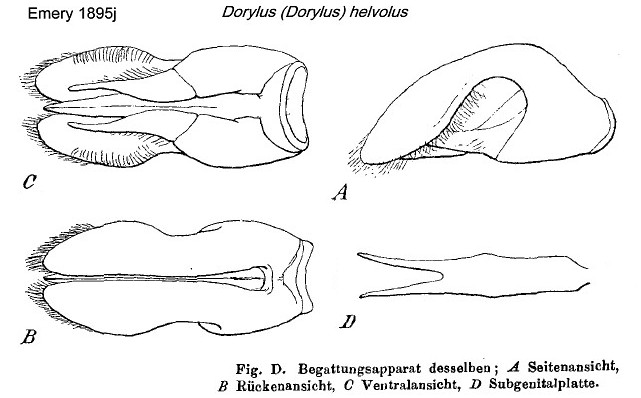
|
 The
photomontage is of a male from the Central African Republic,
1Bayanga-Lidjombo;
collector Philippe Annoyer (CAR 1998-05). The
photomontage is of a male from the Central African Republic,
1Bayanga-Lidjombo;
collector Philippe Annoyer (CAR 1998-05).
|
|